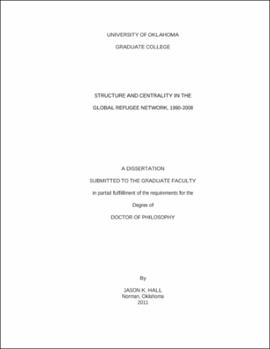| dc.contributor.advisor | Clark, Rob | |
| dc.creator | Hall, Jason K. | |
| dc.date.accessioned | 2019-06-03T20:35:48Z | |
| dc.date.available | 2019-06-03T20:35:48Z | |
| dc.date.issued | 2011 | |
| dc.identifier | 99358646302042 | |
| dc.identifier.uri | https://hdl.handle.net/11244/320216 | |
| dc.description.abstract | This study examines the structure and evolution of global refugee movements through the development of a network census of sending and receiving volume and partnerships between 242 countries and territories across five waves from 1990 to 2008. Degree centrality scores are analyzed using a variety of techniques to investigate three questions related to global refugee movement. These analyses contribute to refugee studies and a number of other disciplines by providing pictures of refugee movement and identifying important relationships that can inform future policy and theory development, as well as humanitarian interventions. | |
| dc.description.abstract | The structure and evolution of the global refugee network is examined in Chapter Three. The refugee network becomes more diffuse from 1990 to 2008, with fewer refugees moving to more destinations. In spite of this diffusion, there tends to be a high degree of stability among the top actors in most permutations of the network. This analysis also identifies an increased refugee burden experienced by countries at middle and low levels of development. Finally, this chapter identifies clear difference between top actors in the dichotomized receiving network and those in the other three networks. Countries at the highest level of development receive refugees from the most partners, but do not receive the highest total numbers of refugees. Countries at middle and low levels of development dominate the lists of top actors in the valued networks and the dichotomized sending network. | |
| dc.description.abstract | Chapter Four examines similarities and differences between the refugee and migrant networks, circa 2000. The migrant network is denser and more active than the refugee network, while the refugee network tends to be more centralized. Correlation analyses demonstrate the two networks are related, but at relatively low levels. In OLS analyses examining the effects of domestic conditions and international integration on degree centrality in the different networks, state strength, conflict, INGO participation, trade openness, and receipt of foreign aid demonstrate similar effects on both migrant and refugee movements. Modernization, environmental, and political instability measures affect refugee movement but not migration. World system position demonstrates the clearest difference between the networks, with peripheral status demonstrating a negative relationship with migrant sending centrality and a positive relationship with refugee sending centrality. In a final set of OLS regressions using residual scores from the regression of the refugee network on its migrant counterpart, economic, political, and international measures all explain some of the observed differences between these networks. | |
| dc.description.abstract | In Chapter Five, random and fixed effects models explore the effects of domestic conditions and international integration on degree centrality in the refugee network from 1990 to 2008. Three important stories emerge. First, economic growth and development are negatively related to valued and dichotomized refugee-sending centrality. Next, countries that experience political instability are more central in the valued and dichotomized refugee-sending networks. Finally, greater foreign investment, trade openness, and INGO participation yield greater levels of refugees and receiving partners than those less involved in these networks, while more limited connections to global trade networks (i.e., lower world system positions) are negatively related to refugees received and partners. | |
| dc.format.extent | 444 pages | |
| dc.format.medium | application.pdf | |
| dc.language | en_US | |
| dc.relation.requires | Adobe Acrobat Reader | |
| dc.subject | Refugees | |
| dc.subject | Human geography--Network analysis | |
| dc.subject | Forced migration | |
| dc.title | STRUCTURE AND CENTRALITY IN THE GLOBAL REFUGEE NETWORK, 1990-2008 | |
| dc.type | text | |
| dc.type | document | |
| dc.thesis.degree | Ph.D. | |
| ou.group | College of Arts and Sciences::Department of Sociology | |
